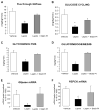Critical role of STAT3 in leptin's metabolic actions
- PMID: 16814732
- PMCID: PMC3638026
- DOI: 10.1016/j.cmet.2006.04.014
Critical role of STAT3 in leptin's metabolic actions
Abstract
Leptin has pleiotropic effects on glucose homeostasis and feeding behavior. Here, we validate the use of a cell-permeable phosphopeptide that blocks STAT3 activation in vivo. The combination of this biochemical approach with stereotaxic surgical techniques allowed us to pinpoint the contribution of hypothalamic STAT3 to the acute effects of leptin on food intake and glucose homeostasis. Leptin's ability to acutely reduce food intake critically depends on intact STAT3 signaling. Likewise, hypothalamic signaling of leptin through STAT3 is required for the acute effects of leptin on liver glucose fluxes. Lifelong obliteration of STAT3 signaling via the leptin receptor in mice (s/s mice) results in severe hepatic insulin resistance that is comparable to that observed in db/db mice, devoid of leptin receptor signaling. Our results demonstrate that the activation of the hypothalamic STAT3 pathway is an absolute requirement for the effects of leptin on food intake and hepatic glucose metabolism.
Figures






Similar articles
-
Anorectic estrogen mimics leptin's effect on the rewiring of melanocortin cells and Stat3 signaling in obese animals.Nat Med. 2007 Jan;13(1):89-94. doi: 10.1038/nm1525. Epub 2006 Dec 31. Nat Med. 2007. PMID: 17195839
-
Palmitic acid induces central leptin resistance and impairs hepatic glucose and lipid metabolism in male mice.J Nutr Biochem. 2015 May;26(5):541-8. doi: 10.1016/j.jnutbio.2014.12.011. Epub 2015 Feb 12. J Nutr Biochem. 2015. PMID: 25724108
-
Leptin-dependent STAT3 phosphorylation in postnatal mouse hypothalamus.Brain Res. 2008 Jun 18;1215:105-15. doi: 10.1016/j.brainres.2008.03.078. Epub 2008 Apr 10. Brain Res. 2008. PMID: 18485333
-
Leptin Signaling in the Control of Metabolism and Appetite: Lessons from Animal Models.J Mol Neurosci. 2018 Nov;66(3):390-402. doi: 10.1007/s12031-018-1185-0. Epub 2018 Oct 3. J Mol Neurosci. 2018. PMID: 30284225 Review.
-
Possible involvement of endoplasmic reticulum stress in obesity associated with leptin resistance.J Med Invest. 2009;56 Suppl:296-8. doi: 10.2152/jmi.56.296. J Med Invest. 2009. PMID: 20224207 Review.
Cited by
-
PPARGC1α gene DNA methylation variations in human placenta mediate the link between maternal hyperglycemia and leptin levels in newborns.Clin Epigenetics. 2016 Jun 22;8:72. doi: 10.1186/s13148-016-0239-9. eCollection 2016. Clin Epigenetics. 2016. PMID: 27340502 Free PMC article.
-
Combined neural inactivation of suppressor of cytokine signaling-3 and protein-tyrosine phosphatase-1B reveals additive, synergistic, and factor-specific roles in the regulation of body energy balance.Diabetes. 2010 Dec;59(12):3074-84. doi: 10.2337/db10-0481. Epub 2010 Sep 28. Diabetes. 2010. PMID: 20876718 Free PMC article.
-
Central insulin and leptin-mediated autonomic control of glucose homeostasis.Trends Endocrinol Metab. 2011 Jul;22(7):275-85. doi: 10.1016/j.tem.2011.03.001. Epub 2011 Apr 12. Trends Endocrinol Metab. 2011. PMID: 21489811 Free PMC article. Review.
-
Loss of phosphatase and tensin homolog (PTEN) induces leptin-mediated leptin gene expression: feed-forward loop operating in the lung.J Biol Chem. 2013 Oct 11;288(41):29821-35. doi: 10.1074/jbc.M113.481523. Epub 2013 Aug 20. J Biol Chem. 2013. PMID: 23963458 Free PMC article.
-
Incendiary Leptin.Nutrients. 2020 Feb 13;12(2):472. doi: 10.3390/nu12020472. Nutrients. 2020. PMID: 32069871 Free PMC article. Review.
References
-
- Ahima RS, Flier JS. Leptin. Annu Rev Physiol. 2000;62:413–437. - PubMed
-
- Barzilai N, She L, Liu L, Wang J, Hu M, Vuguin P, Rossetti L. Decreased visceral adiposity accounts for leptin effect on hepatic but not peripheral insulin action. Am J Physiol. 1999;277:E291–E298. - PubMed
-
- Bates SH, Myers MG., Jr The role of leptin receptor signaling in feeding and neuroendocrine function. Trends Endocrinol Metab. 2003;14:447–452. - PubMed
-
- Bates SH, Stearns WH, Dundon TA, Schubert M, Tso AW, Wang Y, Banks AS, Lavery HJ, Haq AK, Maratos-Flier E, et al. STAT3 signalling is required for leptin regulation of energy balance but not reproduction. Nature. 2003;421:856–859. - PubMed
Publication types
MeSH terms
Substances
Grants and funding
LinkOut - more resources
Full Text Sources
Other Literature Sources
Molecular Biology Databases
Miscellaneous

